Operating Hydrogen-Based Energy Storage Systems in Wind Farms for Smooth Power Injection: A Penalty Fees Aware Model Predictive Control
Abstract
:1. Introduction
- The scenario, i.e., a wind-hydrogen system targeting the use-case energy-storage as per the IEA-HIA Task 24 final report;
- The MLD modeling for including devices’ dynamics depending on logical conditions;
- The MPC-based approach;
- The minimization of the devices’ operating costs.
- Accounting for the power smoothing based on tracking a smooth profile contracted with the Transmission System Operator (TSO);
- Accounting for the participation to the spot market, which is competing with the aim of providing smooth power to the grid, since, for instance, the controller is also pushed not to electrolyze in case of both wind production and spot market prices peak;
- Accounting for the penalties that the wind farm owner/operator incurs in case the delivered power is below a threshold against what contracted;
- Accounting for the inherent hydrogen value, which is competing with the aim of providing smooth power to the grid, yet it is appealing for the wind farm owner/operator for leveraging hydrogen production for other purposes aside from the main one (i.e., power smoothing);
- Simpler devices’ models based on practical considerations about their functioning and cost impacts on the optimal operations;
- Simpler control architecture with no sequential optimization;
- Simulations with real data from a wind farm in the center-south of Italy and real spot prices.
2. Materials and Methods
2.1. MLD Framework
2.2. MPC Schemes
2.3. Assumptions and Notation
2.4. Description of the Scenario
Technology Driven Assumptions
- Stand-by requires very low power, both for the electrolyzer and the fuel cell, that would otherwise need a very long off-duty period in order to be economically convenient to opt for off operations. Therefore, in our mathematical modeling, we do not consider a device can be switched off; in turn, this also implies that cold starts are subsequently not accounted for.
- The sampling time addressed by the controller (order of tens of minutes) is much greater than the timescale across which warm starts take place (order of seconds), which, therefore, are not accounted for.
- The devices have good time-response performance so that some typical limitations such as, e.g., ramp limits, are ineffective at the considered sampling times.
2.5. Devices’ Logic Models
2.5.1. MLD Modeling
2.5.2. Transitions among the Logic States
2.6. Physical Dynamics, Balances and Operating Ranges
2.6.1. Auxiliary Variables for Mixed Products
2.6.2. Hydrogen Level Dynamics
2.6.3. Power Balance
2.6.4. Operating Ranges
2.7. Scenario Objectives and Requirements
2.7.1. Smooth Power Injection
2.7.2. Profits/Fees for Contracted Power Delivery
2.7.3. Costs During Operations
2.7.4. Costs/Opportunities
2.8. Controller Implementation
2.8.1. Vectorized Logic and Mixed Variable Constraints
2.8.2. Vectorized Physical Dynamics, Balances and Operating Ranges
2.8.3. Vectorized Objectives and Requirements
2.8.4. MPC Algorithm
2.9. Relaxation
3. Results
- The wind generation and the energy price forecasts are the same of the actual wind generation and energy price profiles, respectively, i.e., the simulations are conducted under the assumption of perfect forecasts;
- There are no model mismatches, which, in combination with the previous bullet, results in the power injected to the grid and the LoH to be exactly what predicted by the controller (see (37) and (38));
- The price e agreed upon the day before the dispatchment day by the wind farm operator/owner and the TSO and the energy prices s in the spot market (forecasts) are the same, i.e., ;
- In all the considered scenarios, the initial conditions of the devices is and the initial LoH is 0.9 with exceptions where otherwise remarked.
3.1. Scenario 1: Impact of Reference-Tracking Cost
3.2. Scenario 2: Impact of Penalty Fees Cost
3.3. Scenario 3: Impact of Hydrogen Value Cost
3.4. Scenario 4: Full-Feature Operations with N = 18
3.5. Full-Feature Operations in Spring/Summer with N = 18 vs. N = 60
4. Discussion
Author Contributions
Funding
Data Availability Statement
Conflicts of Interest
Abbreviations
| GME | Gestore dei Mercati Energetici |
| HESS | Hydrogen-based Energy Storage System |
| HIA | Hydrogen Implementing Agreement |
| IEA | International Energy Agency |
| LoH | Level of Hydrogen |
| MIL | Mixed-Integer Linear |
| MLD | Mixed-Logic Dynamic |
| MPC | Model Predictive Control |
| TSO | Transmission System Operator |
References
- Hoskin, A.; Pedersen, A.S.; Varkaraki, E.; Pino, F.J.; Aso, I.; Simón, J.; Lehmann, J.; Linnemann, J.; Stolzenburg, K.; Castrillo, L.; et al. IEA-HIA Task 24—Wind Energy & Hydrogen Integration—Final Report; Technical Report; International Energy Agency-Hydrogen Implementing Agreement. 2013. Available online: https://www.ieahydrogen.org/wpfd_file/task-24-final-report/ (accessed on 29 August 2022).
- Zhao, X.; Yan, Z.; Xue, Y.; Zhang, X.P. Wind Power Smoothing by Controlling the Inertial Energy of Turbines with Optimized Energy Yield. IEEE Access 2017, 5, 23374–23382. [Google Scholar] [CrossRef]
- Lyu, X.; Zhao, J.; Jia, Y.; Xu, Z.; Po Wong, K. Coordinated Control Strategies of PMSG-Based Wind Turbine for Smoothing Power Fluctuations. IEEE Trans. Power Syst. 2019, 34, 391–401. [Google Scholar] [CrossRef]
- Lyu, X.; Jia, Y.; Xu, Z.; Ostergaard, J. Mileage-Responsive Wind Power Smoothing. IEEE Trans. Ind. Electron. 2020, 67, 5209–5212. [Google Scholar] [CrossRef]
- Mahmoudi, N.; Saha, T.K.; Eghbal, M. Wind Power Offering Strategy in Day-Ahead Markets: Employing Demand Response in a Two-Stage Plan. IEEE Trans. Power Syst. 2015, 30, 1888–1896. [Google Scholar] [CrossRef]
- Li, C.; Yao, Y.; Zhao, C.; Wang, X. Multi-Objective Day-Ahead Scheduling of Power Market Integrated With Wind Power Producers Considering Heat and Electricity Trading and Demand Response Programs. IEEE Access 2019, 7, 181213–181228. [Google Scholar] [CrossRef]
- Yang, Y.; Qin, C.; Zeng, Y.; Wang, C. Optimal Coordinated Bidding Strategy of Wind and Solar System with Energy Storage in Day-ahead Market. J. Mod. Power Syst. Clean Energy 2022, 10, 192–203. [Google Scholar] [CrossRef]
- Abdelghany, M.B.; Faisal Shehzad, M.; Liuzza, D.; Mariani, V.; Glielmo, L. Modeling and Optimal Control of a Hydrogen Storage System for Wind Farm Output Power Smoothing. In Proceedings of the 2020 59th IEEE Conference on Decision and Control (CDC), Jeju, Korea, 14–18 December 2020; pp. 49–54. [Google Scholar] [CrossRef]
- Koiwa, K.; Ishii, T.; Liu, K.Z.; Zanma, T.; Tamura, J. On the Reduction of the Rated Power of Energy Storage System in Wind Farms. IEEE Trans. Power Syst. 2020, 35, 2586–2596. [Google Scholar] [CrossRef]
- Yang, M.; Zhang, L.; Cui, Y.; Zhou, Y.; Chen, Y.; Yan, G. Investigating the Wind Power Smoothing Effect Using Set Pair Analysis. IEEE Trans. Sustain. Energy 2020, 11, 1161–1172. [Google Scholar] [CrossRef]
- Barra, P.; de Carvalho, W.; Menezes, T.; Fernandes, R.; Coury, D. A review on wind power smoothing using high-power energy storage systems. Renew. Sustain. Energy Rev. 2021, 137, 110455. [Google Scholar] [CrossRef]
- Lamsal, D.; Sreeram, V.; Mishra, Y.; Kumar, D. Output power smoothing control approaches for wind and photovoltaic generation systems: A review. Renew. Sustain. Energy Rev. 2019, 113, 109245. [Google Scholar] [CrossRef]
- Zhai, Y.; Zhang, J.; Tan, Z.; Liu, X.; Shen, B.; Coombs, T.; Liu, P.; Huang, S. Research On the Application of Superconducting Magnetic Energy Storage in the Wind Power Generation System For Smoothing Wind Power Fluctuations. IEEE Trans. Appl. Supercond. 2021, 31, 1–5. [Google Scholar] [CrossRef]
- Yang, R.H.; Jin, J.X. Unified Power Quality Conditioner with Advanced Dual Control for Performance Improvement of DFIG-Based Wind Farm. IEEE Trans. Sustain. Energy 2021, 12, 116–126. [Google Scholar] [CrossRef]
- Wang, B.; Cai, G.; Yang, D. Dispatching of a Wind Farm Incorporated With Dual-Battery Energy Storage System Using Model Predictive Control. IEEE Access 2020, 8, 144442–144452. [Google Scholar] [CrossRef]
- Sattar, A.; Al-Durra, A.; Caruana, C.; Debouza, M.; Muyeen, S.M. Testing the Performance of Battery Energy Storage in a Wind Energy Conversion System. IEEE Trans. Ind. Appl. 2020, 56, 3196–3206. [Google Scholar] [CrossRef]
- Wan, C.; Qian, W.; Zhao, C.; Song, Y.; Yang, G. Probabilistic Forecasting Based Sizing and Control of Hybrid Energy Storage for Wind Power Smoothing. IEEE Trans. Sustain. Energy 2021, 12, 1841–1852. [Google Scholar] [CrossRef]
- Spichartz, B.; Günther, K.; Sourkounis, C. New Stability Concept for Primary Controlled Variable Speed Wind Turbines Considering Wind Fluctuations and Power Smoothing. IEEE Trans. Ind. Appl. 2022, 58, 2378–2388. [Google Scholar] [CrossRef]
- De Battista, H.; Mantz, R.J.; Garelli, F. Power conditioning for a wind-hydrogen energy system. J. Power Sources 2006, 155, 478–486. [Google Scholar] [CrossRef]
- Little, M.; Thomson, M.; Infield, D. Electrical integration of renewable energy into stand-alone power supplies incorporating hydrogen storage. Int. J. Hydrogen Energy 2007, 32, 1582–1588. [Google Scholar] [CrossRef]
- Takahashi, R.; Kinoshita, H.; Murata, T.; Tamura, J.; Sugimasa, M.; Komura, A.; Futami, M.; Ichinose, M.; Ide, K. Output Power Smoothing and Hydrogen Production by Using Variable Speed Wind Generators. IEEE Trans. Ind. Electron. 2010, 57, 485–493. [Google Scholar] [CrossRef]
- Muyeen, S.; Takahashi, R.; Tamura, J. Electrolyzer switching strategy for hydrogen generation from variable speed wind generator. Electr. Power Syst. Res. 2011, 81, 1171–1179. [Google Scholar] [CrossRef]
- Wen, T.; Zhang, Z.; Lin, X.; Li, Z.; Chen, C.; Wang, Z. Research on Modeling and the Operation Strategy of a Hydrogen-Battery Hybrid Energy Storage System for Flexible Wind Farm Grid-Connection. IEEE Access 2020, 8, 79347–79356. [Google Scholar] [CrossRef]
- Huang, C.; Zong, Y.; You, S.; Træholt, C.; Zheng, Z.; Xie, Q. Cooperative Control of Wind-Hydrogen-SMES Hybrid Systems for Fault-Ride-Through Improvement and Power Smoothing. IEEE Trans. Appl. Supercond. 2021, 31, 1–7. [Google Scholar] [CrossRef]
- Koiwa, K.; Cui, L.; Zanma, T.; Liu, K.Z.; Tamura, J. A Coordinated Control Method for Integrated System of Wind Farm and Hydrogen Production: Kinetic Energy and Virtual Discharge Controls. IEEE Access 2022, 10, 28283–28294. [Google Scholar] [CrossRef]
- Bemporad, A.; Morari, M. Control of systems integrating logic, dynamics, and constraints. Automatica 1999, 35, 407–427. [Google Scholar] [CrossRef]
- Williams, P.H. Model Building in Mathematical Programmin, 5th ed.; John Wiley & Sons Ltd.: Hoboken, NJ, USA, 2013. [Google Scholar]
- Bynum, M.L.; Hackebeil, G.A.; Hart, W.E.; Laird, C.D.; Nicholson, B.L.; Siirola, J.D.; Watson, J.P.; Woodruff, D.L. Pyomo–Optimization Modeling in Python, 3rd ed.; Springer: Berlin/Heidelberg, Germany, 2021; Volume 67. [Google Scholar]
- Hart, W.E.; Watson, J.P.; Woodruff, D.L. Pyomo: Modeling and solving mathematical programs in Python. Math. Program. Comput. 2011, 3, 219–260. [Google Scholar]
- Pyomo.org. 2022. Available online: http://www.pyomo.org/ (accessed on 1 July 2022).
- FICO. 2022. Available online: https://www.fico.com/en/products/fico-xpress-optimization (accessed on 1 July 2022).
- Friendly Power S.r.l. 2022. Available online: http://www.friendlypower.it/ (accessed on 1 July 2022).
- GME—Gestore Mercati Energetici. 2022. Available online: http://www.mercatoelettrico.org/ (accessed on 1 July 2022).
- Atif, A.; Khalid, M. Saviztky-Golay Filtering for Solar Power Smoothing and Ramp Rate Reduction Based on Controlled Battery Energy Storage. IEEE Access 2020, 8, 33806–33817. [Google Scholar] [CrossRef]

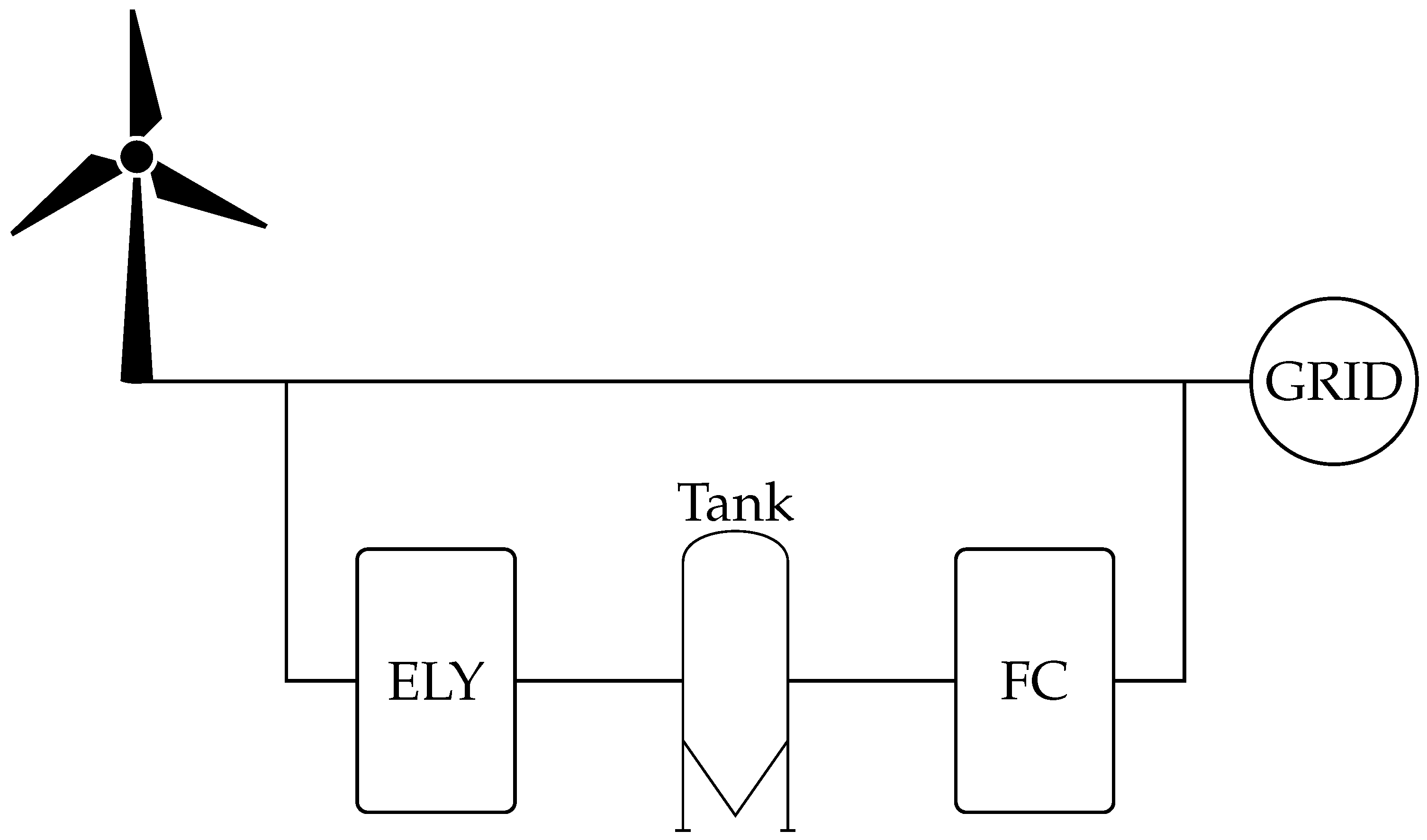

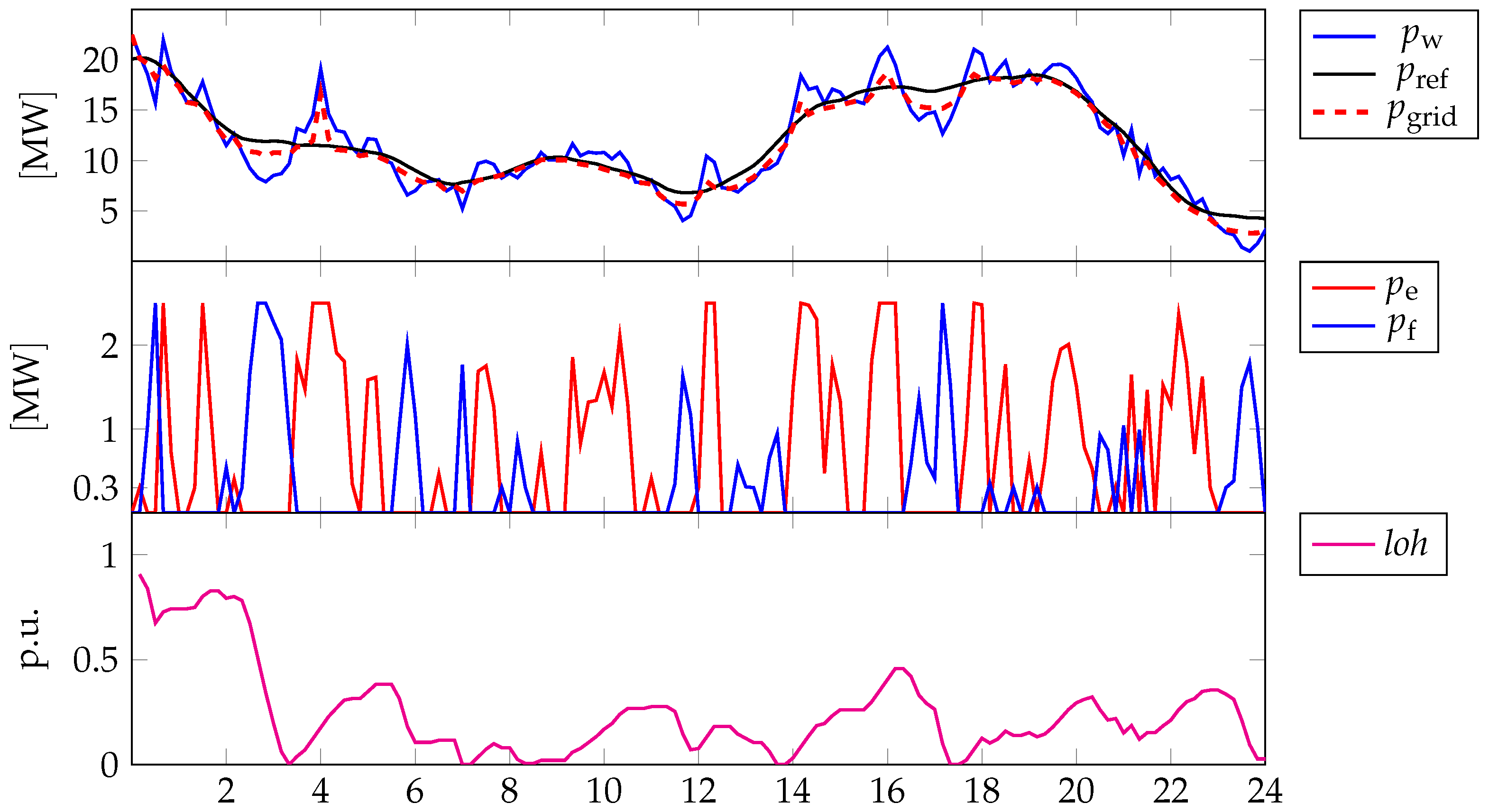




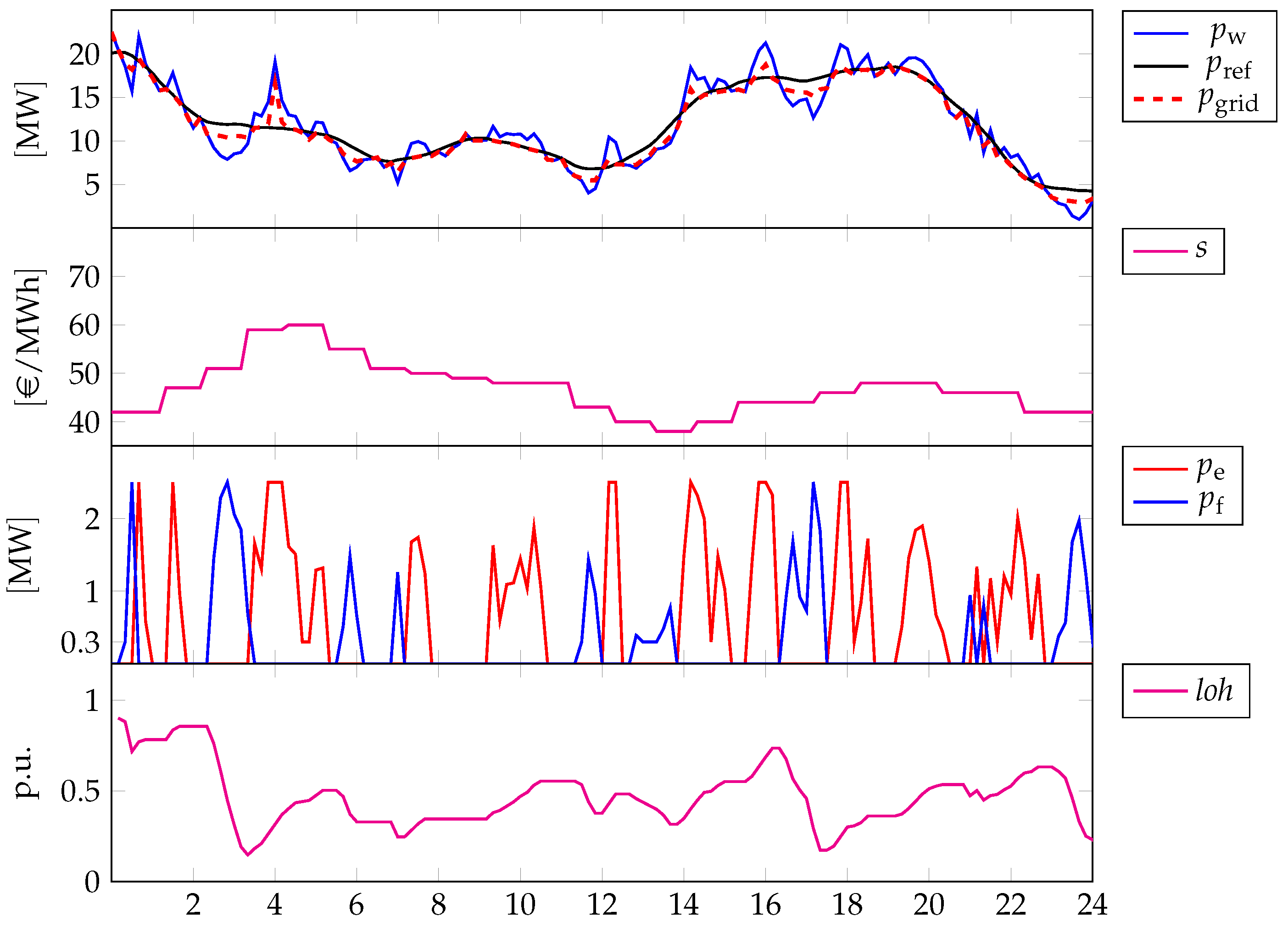
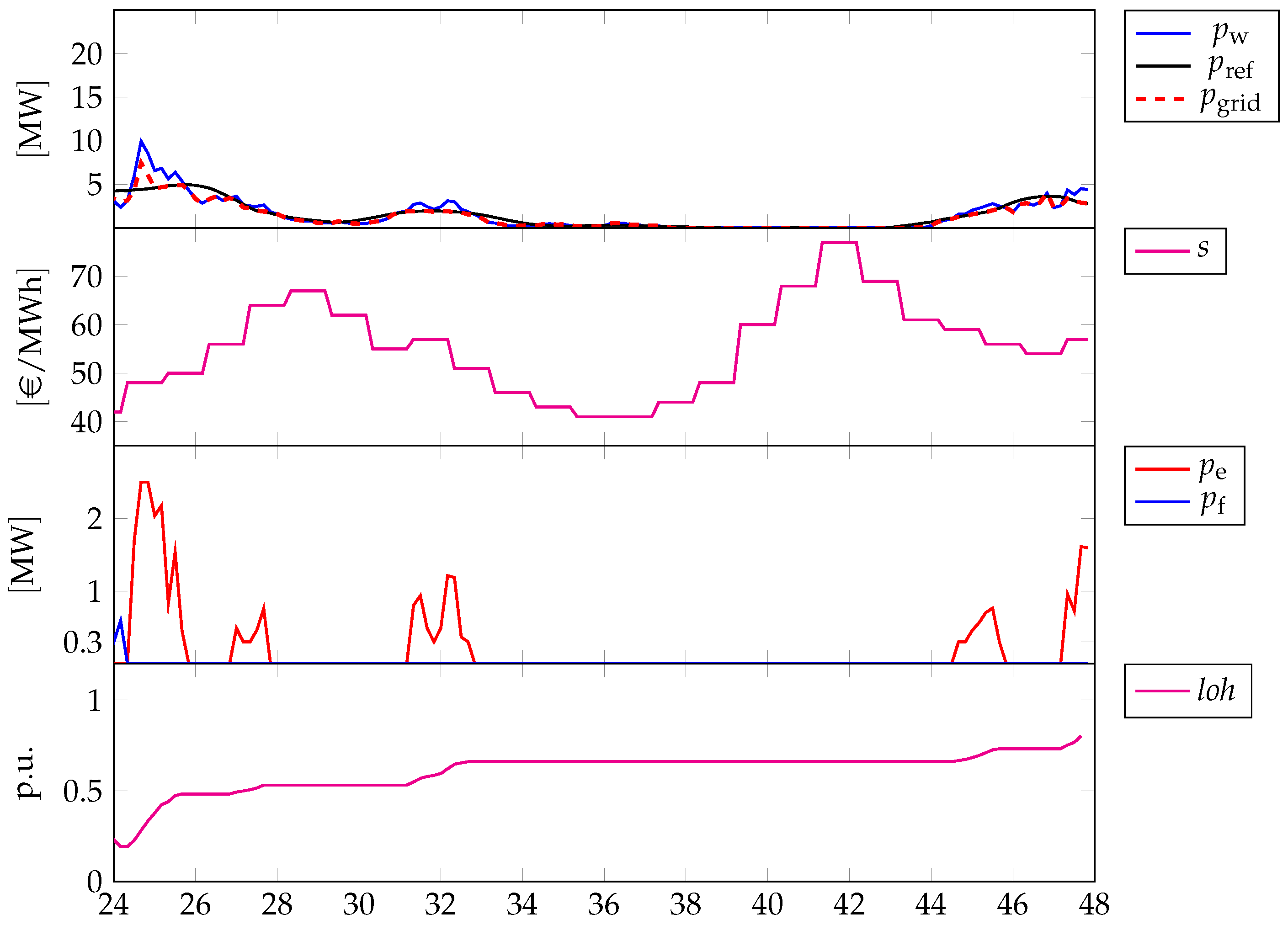

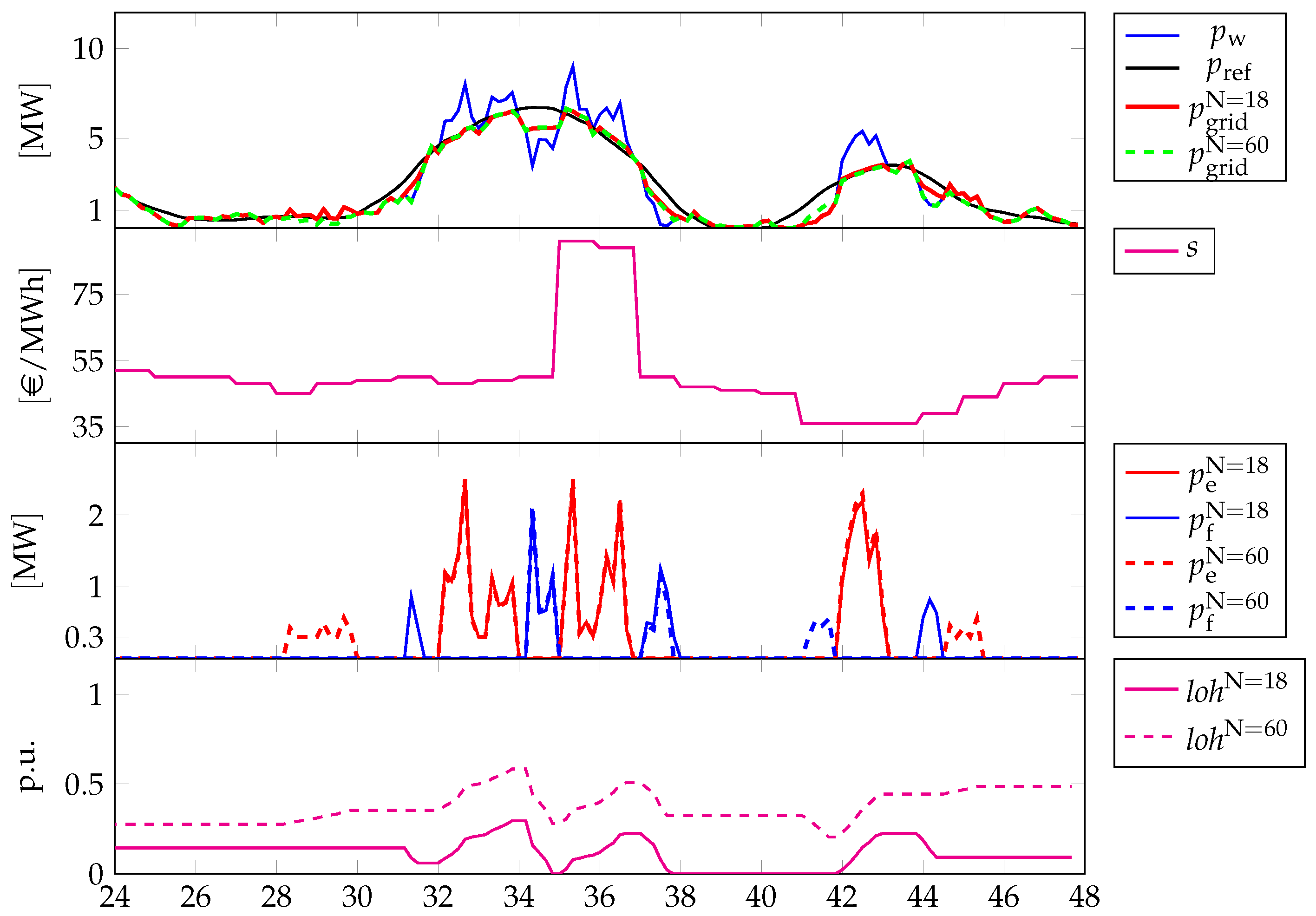

| Variables | |
|---|---|
| Logic variable of a generic state | |
| Logic variable indicating the activation of a penalty fee | |
| Logic variable of two generic states and | |
| Mixed variable of a generic state | |
| Mixed variable involved in the activation of a penalty fee | |
| , | Logic (slack) variables of a generic state |
| Level of hydrogen in the tank | |
| e | Price profile contracted by the wind farm operator/ |
| owner with the Transmission System Operator (TSO) | |
| p | A generic device’s power |
| Power delivered to the grid | |
| Reference power profile to track | |
| Power profile by wind generation | |
| s | Energy prices in the spot market |
| Cost terms | |
| Total costs across a horizon | |
| () | Cost term related to state switchings of a generic device (across a horizon ) |
| () | Cost term related to the level of hydrogen in the tank (across a horizon ) |
| () | Cost term related to the operations of a generic device (across a horizon ) |
| () | Cost term related to the tracking error of a power reference (across a horizon ) |
| () | Cost term related to the activation of a penalty fee (across a horizon ) |
| Total costs across a horizon of a generic device | |
| Labels | |
| STB, ON | Names of logic states of a generic device’s automaton |
| Parameters | |
| Small tolerance | |
| Productivity of the electrolyzer | |
| Productivity of the fuel cell | |
| Cost of hydrogen | |
| Cost for a generic device to switch from to | |
| Cost for a generic device to switch from to | |
| Part of earnings paid by the wind farm operator/owner to a third party company | |
| Set of a generic device’s decision variables across a horizon | |
| Maximum rated amount of hydrogen in the tank | |
| Maximum level of hydrogen in the tank | |
| Minimum level of hydrogen in the tank | |
| Upper-bound estimate of | |
| Upper-bound estimate of | |
| Upper-bound estimate of | |
| Lower-bound estimate of | |
| Upper-bound estimate of | |
| Lower-bound estimate of | |
| Horizon | |
| A generic device’s maximum power when in state | |
| A generic device’s minimum power when in state | |
| Rated power of the electrolyzer in stand-by | |
| Rated power of the fuel cell in stand-by | |
| Maximum rated power of the electrolyzer in on | |
| Minimum rated power of the electrolyzer in on | |
| Maximum rated power of the fuel cell in on | |
| Minimum rated power of the fuel in on | |
| Sampling time | |
| Weight related to the cost term () | |
| Weight related to the cost term () | |
| Weight related to the cost term () | |
| Weight related to the cost term () | |
| Weight related to the cost term () |
| Parameter | Description | Value |
|---|---|---|
| Max. on-power of the electrolyzer | 2500 kW | |
| Min. on-power of the electrolyzer | 300 kW | |
| Stand-by-power of the electrolyzer | 1 kW | |
| (Productivity of the electrolyzer)−1 | 52 kWh/kg | |
| Max. on-power of the fuel cell | 2500 kW | |
| Min. on-power of the fuel cell | 300 kW | |
| Stand-by-power of the fuel cell | 1 kW | |
| Productivity of the fuel cell | 17 kWh/kg | |
| Tank capacity | 150 kg | |
| Min. LoH in the tank | 1 | |
| Max. LoH in the tank | 0 |
| Scenario | Description | Reference Period | Parameter | Value |
|---|---|---|---|---|
| 1 | Isolate and highlight the impact of on wind-hydrogen system operations | From 14:00 of 18 February 2017 to 14:00 of 20 February 2017 | 18 samples (i.e., 3 h) | |
| , | 0 | |||
| , | 0 | |||
| , | 0 | |||
| 2 | Isolate and highlight the impact of on wind-hydrogen system operations | “ | 18 samples (i.e., 3 h) | |
| 2000 kW | ||||
| , | 0 | |||
| , | 0 | |||
| , | 0 | |||
| 3 | Isolate and highlight the impact of on wind-hydrogen system operations | “ | N | 18 samples (i.e., 3 h) |
| , | 0 | |||
| , | 0 | |||
| , | 0 | |||
| 4 | Full-feature operations | “ | N | 18 samples (i.e., 3 h) |
| 2000 kW | ||||
| 3 €/kg | ||||
| 0.03 | ||||
| , | 1, 10 | |||
| , | 1, 10 | |||
| , | 0.015 × 10−3, 0.07 | |||
| 0.2 | ||||
| 5 | Full-feature operations | From 09:00 of 27 May 2017 to 09:00 of 29 May 2017 | 18 samples (i.e., 3 h) | |
| 2000 kW | ||||
| 3 €/kg | ||||
| 0.03 | ||||
| , | 1, 10 | |||
| , | 1, 10 | |||
| , | 0.015 × 10−3, 0.03 | |||
| 0.2 | ||||
| 6 | Full-feature operations | From 09:00 of 29 May 2017 to 09:00 of 31 May 2017 | 60 samples (i.e., 10 h) | |
| 2000 kW | ||||
| 3 €/kg | ||||
| 0.03 | ||||
| , | 0.9, 8.6 | |||
| , | 1, 11 | |||
| , | 0.015 × 10−3, 0.013 | |||
| 0.2 |
Publisher’s Note: MDPI stays neutral with regard to jurisdictional claims in published maps and institutional affiliations. |
© 2022 by the authors. Licensee MDPI, Basel, Switzerland. This article is an open access article distributed under the terms and conditions of the Creative Commons Attribution (CC BY) license (https://creativecommons.org/licenses/by/4.0/).
Share and Cite
Mariani, V.; Zenith, F.; Glielmo, L. Operating Hydrogen-Based Energy Storage Systems in Wind Farms for Smooth Power Injection: A Penalty Fees Aware Model Predictive Control. Energies 2022, 15, 6307. https://doi.org/10.3390/en15176307
Mariani V, Zenith F, Glielmo L. Operating Hydrogen-Based Energy Storage Systems in Wind Farms for Smooth Power Injection: A Penalty Fees Aware Model Predictive Control. Energies. 2022; 15(17):6307. https://doi.org/10.3390/en15176307
Chicago/Turabian StyleMariani, Valerio, Federico Zenith, and Luigi Glielmo. 2022. "Operating Hydrogen-Based Energy Storage Systems in Wind Farms for Smooth Power Injection: A Penalty Fees Aware Model Predictive Control" Energies 15, no. 17: 6307. https://doi.org/10.3390/en15176307







